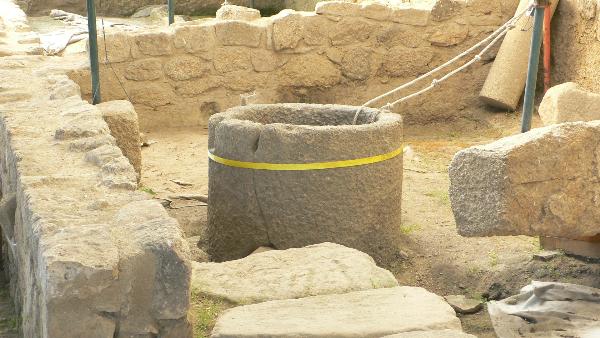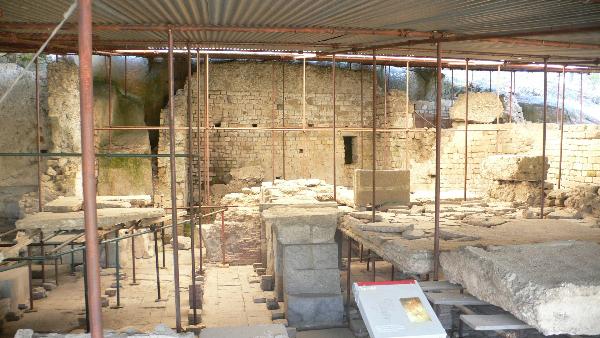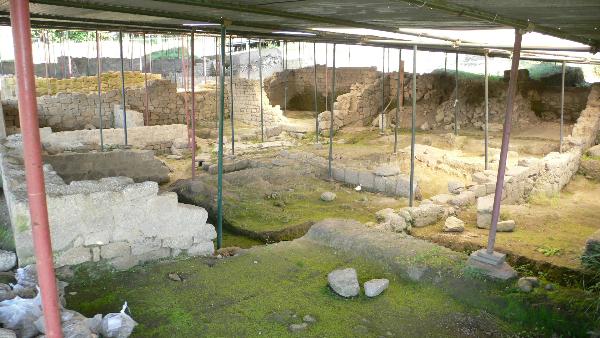![[PT]](https://imgproxy.geocaching.com/fd803be3bfb7396e826555e469c7752394fb37ae?url=http%3A%2F%2Ffarm1.static.flickr.com%2F212%2F481411265_8928121d68_o.gif) Sejam bem vindos a Tongobriga Cidade Romana, estão
prestes a embarcar numa viagem no tempo com destino à época do
Império Romano. Está na altura de vestirem as togas e partir à
descoberta.
Sejam bem vindos a Tongobriga Cidade Romana, estão
prestes a embarcar numa viagem no tempo com destino à época do
Império Romano. Está na altura de vestirem as togas e partir à
descoberta.
Vão ter a oportunidade de ver ao vivo como era
uma cidade romana, o seu majestoso forum, as sempre surpreendentes
termas, os templos, o teatro, a necrópole, as vivendas, mas também
vão ver o que resta de um castro da idade do ferro, um balneário
castrense, sem esquecer a linda aldeia do Freixo, com o solar da
família Serpa Pinto logo à entrada e a sua formosa igreja, em cujas
fundações foram descobertos vestígios de um templo dos inícios do
cristianismo na península ibérica.
A dimensão das ruínas é grande e apenas uma
pequena parte foi escavada, os trabalhos de escavação estão a
decorrer em continuo com equipas de arqueólogos portugueses e
estrangeiros e se tiverem sorte, como eu, vão poder assistir à
descoberta de algo novo e surpreendente.
Quando quiserem tomar algo vão descobrir o mais
surpreendente café, com a sua esplanada alteada por estar sob as
ruínas de uma habitação romana, que podem observar enquanto
relaxam.
![[EN]](https://imgproxy.geocaching.com/26dce0e20e21dd7e2c84c6c439fc1ab0a1b1385f?url=http%3A%2F%2Ffarm1.static.flickr.com%2F179%2F481411263_e6595005a4_o.gif) Welcome to Tongobriga Roman City, you are about to embark on
a journey throught time that will take you to the period of the
Roman Empire. Its time for you to put on your toga and start the
discovery.
Welcome to Tongobriga Roman City, you are about to embark on
a journey throught time that will take you to the period of the
Roman Empire. Its time for you to put on your toga and start the
discovery.
You'll have the oportunity to see how a roman
city used to be, its majestic Forum, the always surprising thermae,
the temples, the theatre, the necropolis, the villas, but also
whats left of an iron age castro and an iron age balnearium and,
lets not forget the lovely village of Freixo, with the Serpa Pinto
manor on its entrance, its beautifull church in which foundations
where discovered vestiges of an early temple from the beginnings of
christianity in the iberia peninsula.
The dimension of the ruins is big and just a
small part of it has been excavated, the excavation works are still
going on with teams of portuguese and foreigner archeologists and
if you are lucky, like i was, you might witness the discovery of
something new and surprising.
If you feel that you might want something to
drink or eat head out to the small and surprising coffee shop with
its heightened esplanade because ist above a roman ruin that you
can see while relaxing.
![[PT]](https://imgproxy.geocaching.com/fd803be3bfb7396e826555e469c7752394fb37ae?url=http%3A%2F%2Ffarm1.static.flickr.com%2F212%2F481411265_8928121d68_o.gif) Tongobriga
Tongobriga
Em 1882, na borda de um poço da aldeia do
Freixo, foi recolhido um bloco granítico paralelepipédico.
actualmente no Museu da Sociedade Martins Sarmento, Guimarães, onde
se lê:
[G]ENIO / [T]ONCOBR / CENSIV[M] /
[FL]AVIUS
V(otum). S(olvit). A(nimo)
Esta referência a Tongobriga aponta para a
existência de uma povoação, situando-se num ponto alto.
Ptolemeu (2,6,38-48) cita a cidade de
Tuntobriga, situando-a entre Douro e Minho, integrada no território
dos Callaeci Bracari. Das interpretações apontadas por diversos
autores, optou-se pelo nome Tongobriga, e identificamos esta cidade
com o actual lugar do Freixo, onde as evidências arqueológicas
confirmam a propriedade da inscrição encontrada em 1882.
 A
urbe Tongobriga começou a ser escavada em Agosto de 1980, num
sitio chamado "capela dos mouros", designação dada pela
população local à pequena parte então visível das ruínas
romanas.
A
urbe Tongobriga começou a ser escavada em Agosto de 1980, num
sitio chamado "capela dos mouros", designação dada pela
população local à pequena parte então visível das ruínas
romanas.
Algumas referências bibliográficas apontavam
para a existência de vestígios arqueológicos geralmente
identificados com um "castro". Ao longo destes anos de investigação
tem sido possível descobrir outros que permitem ampliar a
perspectiva deste sítio.
A estrutura castrejo-romana criada em
Tongobriga, possivelmente com Augusto, amadureceu politica,
administrativa e economicamente, resultando daí a instalação de uma
cidade como consequência da estratégia flaviana de ordenamento da
Tarraconense.
 A
escavação permite dizer que no final do séc. I d.C., e ainda
no séc. II, surge Tongobriga como organismo sócio-económico
que concentra não só elementos residenciais, mas também uma
produção artesanal e actividades sistemáticas de troca que
justificaram a construção do forum. Podemos pensar que surgiu
também nessa época como centro estruturado do poder, civitas,
com natural preponderância sobre a região envolvente e o seu
territorium.
A
escavação permite dizer que no final do séc. I d.C., e ainda
no séc. II, surge Tongobriga como organismo sócio-económico
que concentra não só elementos residenciais, mas também uma
produção artesanal e actividades sistemáticas de troca que
justificaram a construção do forum. Podemos pensar que surgiu
também nessa época como centro estruturado do poder, civitas,
com natural preponderância sobre a região envolvente e o seu
territorium.
O forum de Tongobriga salienta-se pelas suas
dimensões (área de 9 521 m2), englobando os espaços comerciais e
religiosos. Construído no inicio do séc. II d.C., tinha no lado sul
uma plataforma a que se tinha acesso por escadas, onde estavam as
lojas, protegidas pelo telhado de duas águas, suportado por uma
colunata em granito, que cobria todo esse lado do forum. No lado
norte, apresentava-se uma rua com 7 metros de largura, onde se
destacavam duas absides, que terminava numa escadaria próxima das
termas. No lado poente, situava-se o templo. No lado nascente, o
forum era limitado por um edifício cuja função é ainda duvidosa
(eventualmente, a basílica), tal o estado de ruína em que foi
encontrado.
Para construírem em Tongobriga as termas no
final do séc. I d.C., de acordo com um projecto similar, entre
outros, aos de Pompeia, Conimbriga e Ostia, os romanos desactivaram
um balneário castrejo, vulgarmente conhecido como Pedra Formosa,
aqui totalmente esculpido no afloramento granítico.
 A
construção das termas no final do séc. I, do forum na primeira
metade do séc. II, e demais edifícios públicos identificados,
corresponde ao objectivo de dotar este centro urbano de
equipamentos colectivos que, pela sua monumentalidade e
riqueza arquitectónica, impusessem Tongobriga como centro de
atracção e decisão.
A
construção das termas no final do séc. I, do forum na primeira
metade do séc. II, e demais edifícios públicos identificados,
corresponde ao objectivo de dotar este centro urbano de
equipamentos colectivos que, pela sua monumentalidade e
riqueza arquitectónica, impusessem Tongobriga como centro de
atracção e decisão.
Esta cidade, cujo auge identificamos na segunda
metade do séc. II, integrava certamente uma politica de ordenamento
da Tarraconense, particularmente para o Noroeste Peninsular e Norte
da Meseta. Tongobriga ocupava cerca de 50 hectares. Em comparação
com outras cidades romanas, esse espaço permite considerá-la de
médias dimensões. As áreas habitacionais ocupavam cerca de 7
hectares, o que indicia uma população de 2500 pessoas.
Em Tongobriga identificou-se uma necrópole,
"fora de portas", a sul, junto da estrada. Já aqui tinham sido
encontradas peças cerâmicas no final do século XIX aquando da
abertura de um caminho.
As sepulturas escavadas em Tongobriga desde 1980
mostram a predominância do rito da incineração. Neste cemitério, os
romanos abriam valas no afloramento granítico com cerca de 1,5 m de
comprimento, 0,5 m de largura e 0,6 m de profundidade, onde
depositavam as cinzas do corpo, as peças cerâmicas e moedas.
Depois, cobriam a sepultura com lajes de granito e terra.
 No território de Tongobriga, marcado pela serra do Marão e
pelos rios Tâmega e Douro, são abundantes os vestígios
arqueológicos romanos, dos quais identificou-se 125 sítios, o
que comprova a intensa ocupação desta região favorecida pela
circulação que as vias proporcionavam e pela navegabilidade
dos rios Douro e Tâmega.
No território de Tongobriga, marcado pela serra do Marão e
pelos rios Tâmega e Douro, são abundantes os vestígios
arqueológicos romanos, dos quais identificou-se 125 sítios, o
que comprova a intensa ocupação desta região favorecida pela
circulação que as vias proporcionavam e pela navegabilidade
dos rios Douro e Tâmega.
No séc. V, Tongobriga está documentada como
paróquia suévica, após o que se perde no tempo. Hoje é uma pequena
aldeia, estrutura residual organizada em volta da igreja paroquial
que poderá estar sobre a primitiva igreja cristã.
Actualmente, estão classificados como Monumento
Nacional cerca de 50 hectares, espaço designado por Estação
Arqueológica de Freixo. O IPPAR, a que o monumento está afecto,
criou aqui um Gabinete responsável pela sua investigação,
conservação, gestão e divulgação.
![[EN]](https://imgproxy.geocaching.com/26dce0e20e21dd7e2c84c6c439fc1ab0a1b1385f?url=http%3A%2F%2Ffarm1.static.flickr.com%2F179%2F481411263_e6595005a4_o.gif) Tongobriga
Tongobriga
In 1882, on the edge of a well in the village of
Freixo, a granite block with the shape of a parallelepipe was
collected (it is now at Martins Sarmento Museum, in Guimarães) and
on its surface the following can be read:
[G]ENIO / [T]ONCOBR / CENSIV[M] /
[FL]AVIUS
V(otum). S(olvit). A(nimo)
The name Toncobriga refers to a settlement
located in a high place.
Ptolemy (2,6,38-48) mentions the town of
Tuntobriga, as being located in the area between the rivers Douro
and Minho, within the territory of the Callaeci Bracari. Among all
interpretations made by several authors, we chose the name
Tongobriga and we believe this town is the present village of
Freixo, where all the archaelogical vestiges corroborate the
content of the inscriptions found in 1882.
 The town Tongobriga started being excavated in August 1980
in the place called The Chapel of the Moors, name given by the
locals to the small part of the ruins which could be seen by
then.
The town Tongobriga started being excavated in August 1980
in the place called The Chapel of the Moors, name given by the
locals to the small part of the ruins which could be seen by
then.
Some bibliographical references mention the
existence of archaelogical vestiges usually identified a an "iron
age settlement". Over these years of investigations it has been
possible to find out others which allow a wider chronological
analysis of the site.
The iron age settlement structure established in
Tongobriga, probably by Augustus, went through a process of
political, administrative and economical evolution and, as a result
of that, a town was founded following the Flavian strategy to
organise the Tarraconensis.
The excavations shows that by the end of the
first century B.C. and still in the second century, Tongobriga
emerges as a social-economical organisation which gathers together
not only residential elements but also a domestic kind of industry
and regular trade activities, all of which would be reason enough
for the building of the Forum. We think that it was also by that
time that Tongobriga came to existence as a structured centre of
power. Civitas, with a natural preponderance over the surrounding
area and the territorium.
 Built at the beginning of the 2nd century A.D. Tongobriga
forum has an area of 9 521 m2, including commercial and
religious spaces. On the southern side three sets of stairs
give access to the commercial platform. Shops were protected
by a roof, which was supported by granite columns. On the
northern side, the forum has a 7 meters wide street, which
leads to the thermae. This street also has two apsis. On the
east side there was a temple. The west side of the forum was
limited by a building, probably the basilica, but the remains
haven't confirmed that possibility yet. Nearby are the
thermae, accessed to from the northeast side of the forum.
Built at the beginning of the 2nd century A.D. Tongobriga
forum has an area of 9 521 m2, including commercial and
religious spaces. On the southern side three sets of stairs
give access to the commercial platform. Shops were protected
by a roof, which was supported by granite columns. On the
northern side, the forum has a 7 meters wide street, which
leads to the thermae. This street also has two apsis. On the
east side there was a temple. The west side of the forum was
limited by a building, probably the basilica, but the remains
haven't confirmed that possibility yet. Nearby are the
thermae, accessed to from the northeast side of the forum.
Like they did in other cities of the empire
(Pompeii, Conimbriga and Ostia), Romans closed an iron age
balnearium known as Pedra Formosa Balnearium (in Tongobriga it was
a balnearium with three chambers carved on the rock) in order to
build their own thermae in the 1st century A.D.
 The building of the public baths at the end of the 1st
century, of the forum in the first half of the 2nd century and
other public buildings already identified, make it clear that
the establisment in this town of collective buildings, with
their sumptuosity and architectonical magnificence, aimed at
making of Tongobriga a centre of attraction and decision.
The building of the public baths at the end of the 1st
century, of the forum in the first half of the 2nd century and
other public buildings already identified, make it clear that
the establisment in this town of collective buildings, with
their sumptuosity and architectonical magnificence, aimed at
making of Tongobriga a centre of attraction and decision.
This town, which had its highlight on the second
half of the 2nd century, was certainly part of the settlement
strategy of the Tarraconensis particularly towards the Northwest of
the Peninsula and the North of the Meseta. Tongobriga filled an
area of 50 hectares, including the necropolis. If compared to other
roman towns, it can be considered middle-sized. The residential
areas fill about 7 hectares, which means a population of 2500
people.
 In Tongobriga a necropolis was identified outside the city
limits near the main road. Some clay pieces had already been
found there by the end of the 19th century.
In Tongobriga a necropolis was identified outside the city
limits near the main road. Some clay pieces had already been
found there by the end of the 19th century.
Remains found in the graves, since 1980, show
the predominance of incineration rituals. In this necropolis Romans
opened graves in the granite rock with 1,5 metres lenght, 0,5
metres whidth and 0,6 metres height where they put the body ashes,
some pieces of pottery and coins. Then, graves were covered with
large flat granite stones.
In Tongobriga territorium, 125 places with Roman
remains have been identified. This number of archaelogical sites is
justified by the existence of the rivers Douro and Tâmega and Roman
roads, which provide access to the main region.
There are documents according to which
Tongobriga was considered a Suevi parish in the 5th century.
Nowadays it is a small village, which has been built on and with
the remains of the ruins. It is organised around the Parish Church,
which may be standing on top of the original Christian Church.
For the time, about 50 hectares are classified
as National Monument whose name is Estação Arqueológica de Freixo.
The Portuguese Institute for Architectonic Heritage (IPPAR) leads
the investigation of the archaelogical site.
![[PT]](https://imgproxy.geocaching.com/fd803be3bfb7396e826555e469c7752394fb37ae?url=http%3A%2F%2Ffarm1.static.flickr.com%2F212%2F481411265_8928121d68_o.gif) Horário da Estação Arqueológica
Horário da Estação Arqueológica
Embora a cache esteja fora da zona onde se tem
que pagar um ingresso para visitar, aqui fica o horário.
Horário:
9h00 ás 12h30
14h00 ás 17h30
Encerra às segundas-feiras
Aconselha-se a marcação de uma visita com guia,
não vai pagar mais por isso, basta telefonar para o 255 531 090 ou
enviar um e-mail para aafreixo@ippar.pt para marcar.
![[EN]](https://imgproxy.geocaching.com/26dce0e20e21dd7e2c84c6c439fc1ab0a1b1385f?url=http%3A%2F%2Ffarm1.static.flickr.com%2F179%2F481411263_e6595005a4_o.gif) Archeological Station Opening hours
Archeological Station Opening hours
Although the cache is outside the area where you
must pay an entrance fee to visit, for those interested here is the
opening timetable.
Opening hours:
9.00 AM - 12.30 PM
2.00 PM - 5.30 PM
Closed on Mondays
It´s advisible to arrange a visit with a guide,
you won´t pay more for that, just phone 255 531 090 or send an
e-mail to aafreixo@ippar.pt .
![[PT]](https://imgproxy.geocaching.com/fd803be3bfb7396e826555e469c7752394fb37ae?url=http%3A%2F%2Ffarm1.static.flickr.com%2F212%2F481411265_8928121d68_o.gif) A Cache
A Cache
Vai procurar um tupperware rectangular de
tamanho pequeno envolto num saco de plástico preto.
Conteudo inicial da cache: Logbook, stashnote,
lapiseira, geocoin, imagem de homem da antiguidade e mola
decorativa artesanal.
A cache não se encontra na zona das ruínas
romanas por causa das constantes escavações, mas a poucos metros de
um castro da idade do ferro. Apesar da aldeia ter só 12 habitantes
permanentes, são 12 pares de olhos muito atentos às movimentações
dos visitantes, sejam muito discretos na vossa busca.
Para facilitar o acesso à zona da estação
arqueológica forneço um waypoint com o ponto onde devem sair da
estrada principal e também local de estacionamento
preferencial.
Para que esta cache
seja sempre uma surpresa, por favor não publique fotografias ou
logs que possam revelar a localização e como
encontrou-a.
![[EN]](https://imgproxy.geocaching.com/26dce0e20e21dd7e2c84c6c439fc1ab0a1b1385f?url=http%3A%2F%2Ffarm1.static.flickr.com%2F179%2F481411263_e6595005a4_o.gif) The Cache
The Cache
You are going to search for a small sized
rectangular tupperware wrapped inside a black plastic bag.
Cache initial content: Logbook, stashnote,
pencil, geocoin, image from an antiquity man, handmade decorative
spring.
Because of the on going excavations the cache
isn't near te roman ruins, but a short meters from an iron age
castro. Although the village has only 12 inhabitants, they have 12
pairs of very attentive eyes, so be very discrete when searching
for the cache.
To help your way to the archeological station
there are two waypoints provided, one is the spot were you should
leave the main road, the other the recomended parking for your
car.
To keep the surprise
please don't publish photos or logs that might reveal the cache
location and how you found it.